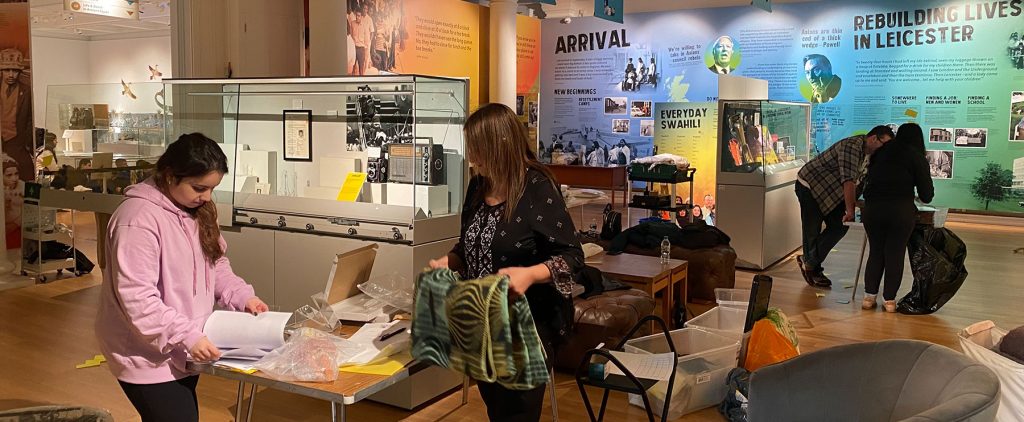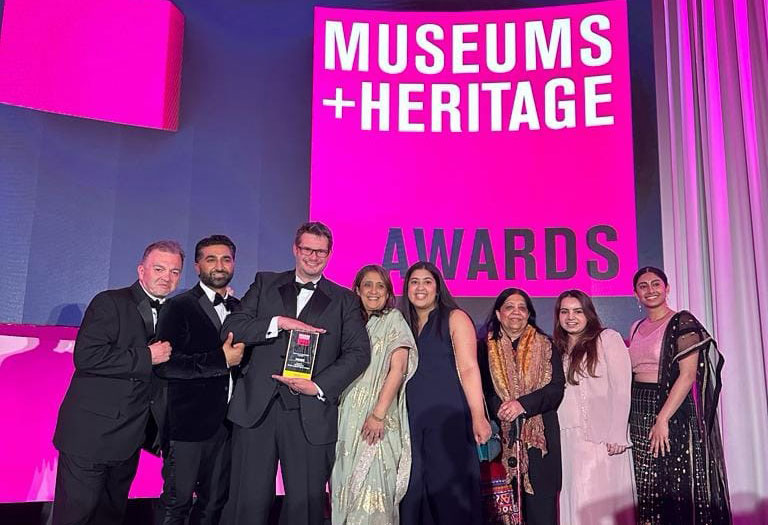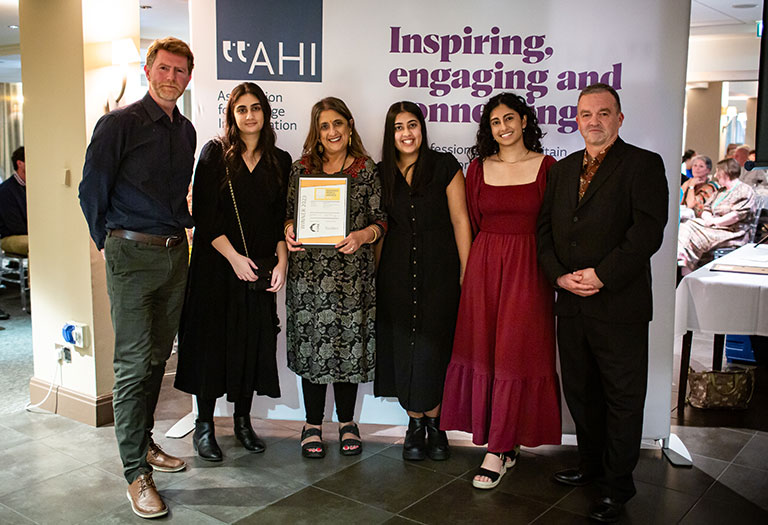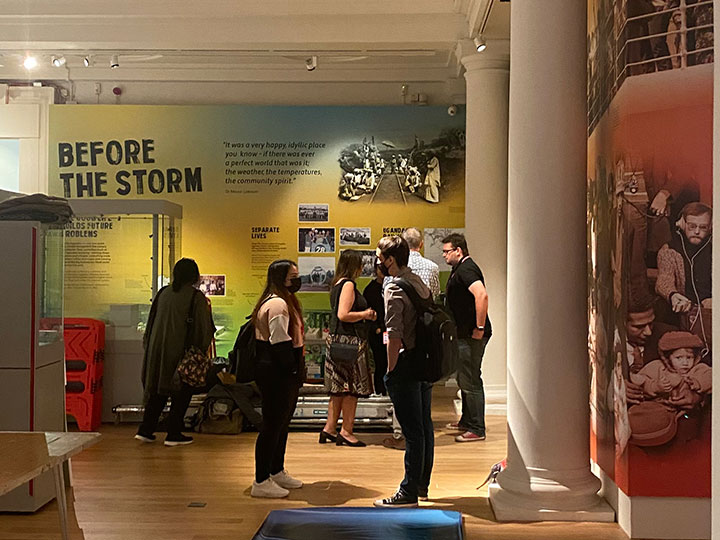Rebuilding Lives: The Story…
Phase 1: Leicester Museum & Art Gallery (LMAG)
The first venue to host the new exhibition (still with the ‘Uganda 50’ working title) was Leicester City Museum’s flagship museum and art gallery, which despite a recent renaming, is still commonly referred to as New Walk Museum. We had been allocated a large gallery (over 155 square metres) on the museum’s first floor, which had recently been decommissioned as the ‘World Cultures Gallery’, meaning the Navrang exhibition would be the first in the newly refurbished gallery.
Phase 1: Leicester Museum & Art Gallery (LMAG)
The first venue to host the new exhibition (still with the ‘Uganda 50’ working title) was Leicester City Museum’s flagship museum and art gallery, which despite a recent renaming, is still commonly referred to as New Walk Museum. We had been allocated a large gallery (over 155 square metres) on the museum’s first floor, which had recently been decommissioned as the ‘World Cultures Gallery’, meaning the Navrang exhibition would be the first in the newly refurbished gallery.
Research and Content Capture
One of the biggest challenges faced by the project team was the complete lack of any collection or material relating the Ugandan Asian community in the Leicester City Museum’s collections, other than those already loaned by the community and on display in a small permanent gallery in the service’s Newarke Houses Museum. This meant that all of the objects and content for the new exhibition would have to be sourced entirely from the Leicester’s Ugandan Asian community and through its own network of contacts.
From the outset, there was a great deal of contact with Ugandan Asian community organisations and individuals through virtual and face-to-face meetings to raise awareness of the project and encourage participation in it. To further engage the wider Ugandan Asian community in Leicester with the project and to help gather objects, photographs and lived experiences for use in the exhibition, Navrang worked with Belgrave Library (at the heart of the Ugandan Asian ‘Golden Mile’ in the city) to host a Memory Day. To advertise the event, we used local radio, social media and other networks to invite the community to the library with any objects or photographs from either their lives in Uganda before expulsion or here in the UK over the past 50 years. From this initial event, we gathered tens of personal stories (some recorded there and then and others we made note of and then arranged more formal interviews at a later date), looked at dozens of objects and personal items and recorded copies of many old photographs. With this initial influx we became confident that we would be able to gather enough content to not only fill the exhibition, but to also ensure that, rather than a ‘book on the wall’, we could fill the gallery with real and emotive stories.
With the collection and identification of content underway and a programme of interviews to capture the personal stories from the local Ugandan Asian community in progress (by the end of the project, over 80 oral histories were collected for the project via face-to-face and virtual interviews conducted by over a dozen Navrang volunteers, all trained by the East Midlands Oral History Archive staff), the team could start the task of researching the broader context for the story. This work was led by Graham Black, who defined the parameters of the research, which was then undertaken by himself, our student volunteers and other members of the team. In addition to discussion with expert academics in the subject, this research also included visits to local and national museums and archives and even contact with organisations, archives and collections in Uganda and neighbouring African countries. Through all of these avenues the team gained access to historic data and documents, archive film footage and photos and key first-hand accounts highlighting the people, places and events which shaped the international, national and local contexts to the 1972 Uganda Crisis and its aftermath.
Add in a sentence discussing the following Also note that there was a lot of contact with community organisations and individuals via zoom and in person to both raise awareness and encourage participation – prior to the memory day.
Curation and Design
From the outset, both the Navrang Project group and our Lead Curator, Graham Black, were united in the vision that it had to be the stories of the people that lived through the expulsion and the Ugandan Asian resettlement in Leicester that had to be at the forefront of the exhibition narrative. Furthermore, they believed that the completed gallery should offer relative ‘experiences’ that echoed or reflected the locations and moods indicative of each element of the story. Thankfully, our designers, Image Makers, and, in particular the Project Manager assigned to work with us, completely embraced our approach and the emotional tones we were trying to evoke, even with our limited budget. Through weeks of brainstorming, discussion, negotiation and a strong commitment to doing justice to the precious stories and objects we had been entrusted with, and after several stylistic iterations, we settled upon the a design approach that gave a structural coherence to the narrative, elements of immersive experience and opportunities for visitor interaction and reflection.
Visitor Numbers and Feedback
By the end of its extended run at LMAG, the Rebuilding Lives: 50 Years of Ugandan Asians in Leicester exhibition had received a staggering 167,402 visitors, some coming from as far away as Sweeden, Canada and North America. Many of these visitors left feedback about their experience of the exhibition on the memory tags on the Mango Tree, in the comments books or on the comments wall. Comments included:
“Make it Permanent!” … Fills a “Massive Void” … “Made me reflect on moving from Ukraine… how it felt and where I am now” … “As a child in 1970’s Leicester… [I] did not understand what was behind the influx of Asians into the city. It has been fascinating… to learn about what circumstances brought Asians here and how they flourished.” … “What an eye-opening, heart-stopping, heart-breaking exhibition”
Recognising the impact the exhibition had had on LMAG itself, the museum’s Operations Manager offered the following summation:
“The exhibition has been a ground-breaking exhibition in retelling a very important story as part of the evolution of the City’s demography and the life journey made by the south Asian diaspora, a story that is typical of enforced migration.
The exhibition has enabled the museum to retell the story and attract new audiences from both within the City and beyond.
A story that resonates with so many who equally have experienced the impact of uprooting and starting over in foreign lands, a story that exposes people’s resilience to overcome the greatest of odds while valuing and preserving their culture at the core of each community, that makes a community a community. A story that enabled and mobilised audiences to visit a museum for a new experience, where previously they may not have, simply because they may not have thought museums are for them.”

Phase 2: Charnwood Museum, Loughborough
As with the LMAG Exhibition, we needed to identify and collect all the objects for the Charnwood version of Rebuilding Lives from the local community. Therefore, as we had in Leicester, we organised a Memory Day in Loughborough’s Fearon Hall and Community Centre. Fortunately, to help us engage with Loughborough’s Ugandan Asian community, we had partnered with a local community group of South Asian ladies called Anand Mangal. Thanks to this event we were able to, once again, speak to Ugandan Asians who had settled in Loughborough after the expulsion and begin to capture their stories, along with the stories of local people who had helped them settle and integrate into the town.
Research and Content Creation
Having already researched and sourced content related to international and national context for the LMAG exhibition, we focussed our research efforts on collating the stories and gathering objects from the local community. Incredibly, people had kept some amazing objects for over 50 years! These included home movie footage, wedding dresses and personal object brought all the way from Uganda, as well as items given to the newly arrived refugees, like blankets for warmth and even a pair of curtains to help furnish the empty house rented to them by the council. Along with the objects came a wealth of powerful oral histories, which we captured for the exhibition. These stories were not just from the Ugandan Asians themselves, but also others who already lived in Loughborough at the time. This included a Student Union officer from Loughborough College who fought for financial aid and academic support for a student who found himself stateless as a result of the expulsion, and a young mother who began teaching English language lessons and aspects of British culture to Ugandan Asian ladies.
Design & Curation
Although the design concept had been developed, the challenge with this version of the exhibition was that the gallery was a third of the size of the LMAG exhibition space. Therefore, in terms of curation and design, we had to condense the overarching narrative of the original exhibition, but still find ways to maintain its impact on visitors.
To help achieve this ‘wow’ factor, one of the first things that visitors saw as they entered the gallery was a new, bespoke made, Memory Mango Tree. As with the LMAG version, this tree soon became festooned with luggage tags filled with the thoughts and memories of visitors and really made an impact upon entering the space.
Then, using the same vinyl wallpaper to print all the text and graphics as we had at LMAG, we covered two gallery walls with the core exhibition narrative, including the introduction, Before the Storm, Expelled, Journey, Arrival, Rebuilding Lives: Settling in Loughborough, and 50 Years On. Although the contextual graphics and text were the same as the Leicester exhibition, where we had examples of images and relevant quotes from the Loughborough community, we used these to ensure that this exhibition really showcased the voices and experiences of local people. These were then enhanced by the inclusion of Loughborough oral histories, accessible via the tablet and headphones in gallery and on smart devices via the QR codes embedded in the text across the exhibition.
Visitor Numbers and Feedback
The inclusion of the post-it Visitor Feedback wall and another Memory Mango Tree, complete with luggage tags for people to record and share their thoughts and memories proved very popular again, with hundreds of comments left by visitors by the end of the exhibition. The messages left by visitors were very powerful as people shared how they were impacted by the expulsion and arrival in Loughborough, and/or how the exhibition had increased their own understanding of how and why the demographics of Leicester and Leicestershire had changed so much in the 70’s. Perhaps the most poignant comments though were those left by current Asylum Seekers and Refugees, especially those recently arrived from Ukraine, and all of which expressed their gratitude to the town and people of Loughborough and how the exhibition had helped them to see how they were not the first displaced people to be welcomed by the town.
The Rebuilding Lives: 50 Years of Ugandan Asians in Loughborough exhibition was scheduled to run from October 2022 to mid-January 2023. However, thanks again to its popularity with the local community, the exhibition was extended by 5 weeks to the end of the February half term holidays in 2023. Over its duration, the exhibition received a fantastic 9,341 visitors, far exceeding our expectations for the venue.
Final Facts and Figures
| Project Objective: | Target Number: | Final Number: |
| Oral Histories Collected | 21 | 82 |
| Volunteers Engaged | 30 | 66 |
| Visitors to Exhibitions | 60,000 | 176,743 (LMAG: 167,402, Charnwood: 9,341) |
| Pop-Up Exhibition Venues | 20 | 56+ venues (from London to North Yorkshire) |
| Public Events Delivered | 20 | 43 Delivered |
| Schools Engaged | 20 | 21 Schools – 11,035 pupils directly engaged |
Phase 3 – Beyond Leicester Exhibitions
Yorkshire
Shortly after opening the Leicester exhibition in July 2022, we were contacted by an Ugandan Asian refugee whose family had settled in Birmingham and was now living in York. Having visited the Rebuilding Lives exhibition, she wondered if there was a way to develop an exhibition telling the York Story.
We introduced her to the Pop-Up Leicester/shire versions we had produced. These were well received, and we began discussing the potential for creating a bespoke version of the pop-up exhibition, that used stories and photographs from Ugandan Refugees in Yorkshire. We agreed that we could support the production of a set of 8 single-sided pull-up banners. The Narang Team conducted the oral history interviews and developed and curated the exhibition.
Despite the tight timescales, the work was completed, and the Pop-Up exhibition was launched at the Yorkshire Integration Festival as planned, with a member of the Navrang team joining the organisers for the event, delivering the Leaving Home and Refugee Quiz activities to support the launch. The exhibition proved extremely popular with visitors, including a number of local organisations, universities and faith centres from across the region who approached the organisers about bringing the exhibition into their venues.
Peterborough
In early October 2022, just prior to the launch of the Charnwood Museum exhibition, we were contacted by Peterborough City Council, who wanted to mark the 50th anniversary of the expulsion and the work of a local councillor at the time, who had worked tirelessly to welcome Ugandan Asian refugees to the city.
Again, the timescales were tight, with a celebration event already scheduled for 29th October that year. After engagement with the community in Peterborough the Navrang Team sourced material to create and develop a Peterborough focused exhibition.
The Peterborough version of the Rebuilding Lives exhibition was completed on time and it took centre-stage at a celebration event in the town which brought together the local Ugandan Asian community, civic leaders and the family of Councillor Swift, who had been so instrumental in welcoming the community to the city.
Phase 4 - Learning
As part of the funding application, Navrang wanted to be able to engage formal learning audiences with the exhibition, especially those in Leicester and Leicestershire as the Ugandan expulsion and its subsequent consequences have had such a major impact on the city and county over the past 50 years.
Once the exhibitions in Leicester and Loughborough was open, we ran a successful schools programme engaging 21 schools and 11,035 students.
To ensure ongoing legacy and use of these resources we enlisted primary and secondary school teachers to support and advise on the creation of these resources and discussions have been had with the exam board, Pearson EdExcel, who’s GCSE syllabus as a result now includes the Ugandan Asian Crisis topic and who are ready to include signposts to our new content as part of their guidance to schools for the topic.
Awards and Accolades

Museum + Heritage Awards
WINNER: Temporary or Touring Exhibition of the Year 2023

Association of Heritage Interpretation (AHI) Awards
WINNER: Community Engagement Project of the Year 2023







